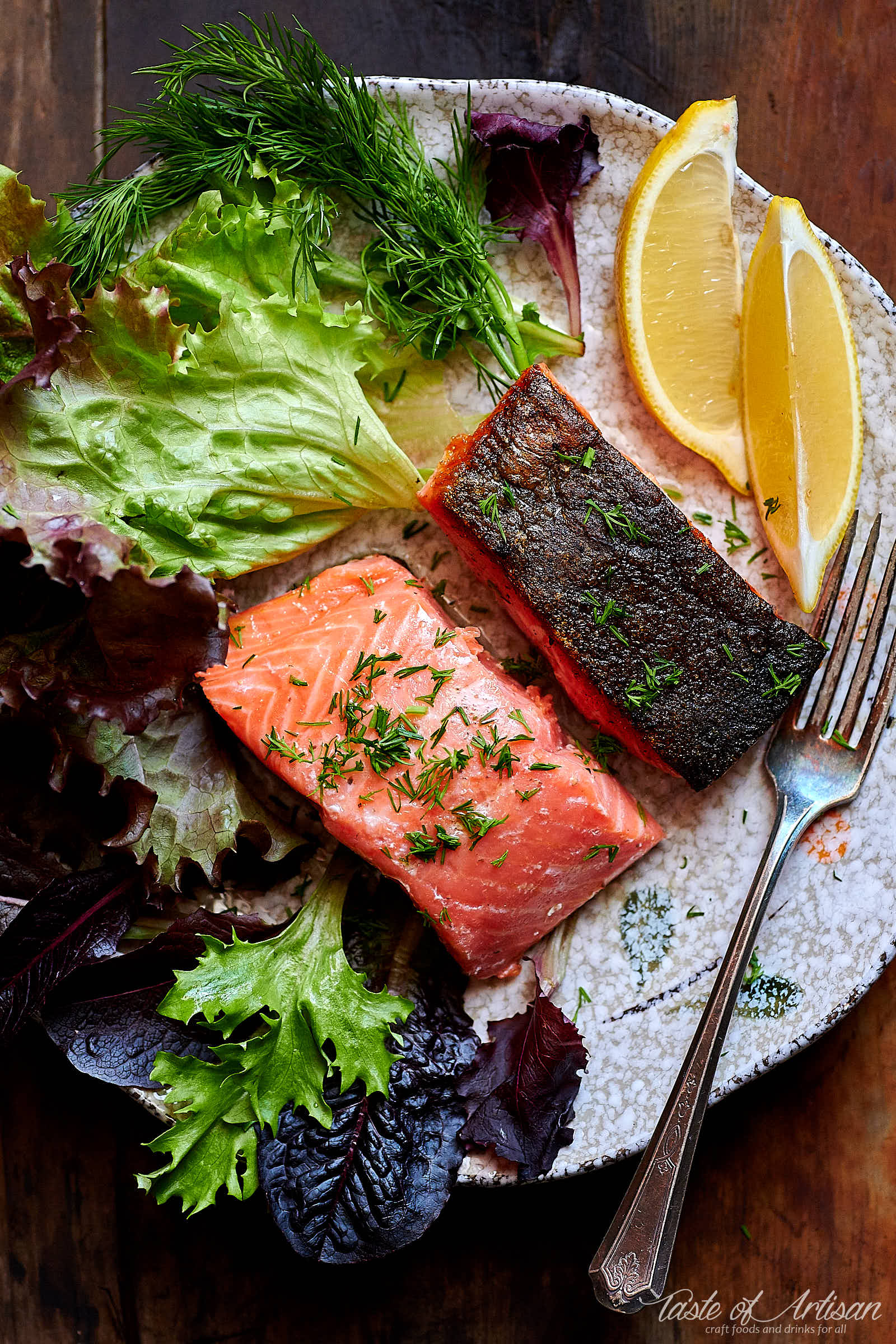 Are you looking to make perfectly cooked, moist, tender and flaky salmon? Sous vide salmon is it. Sous vide salmon is hard to overcook and the process is very easy even for a novice cook. Salmon cooks fairly quickly, allowing you to get away without any specialized equipment for this recipe. Though, an immersion circulator would make cooking super simple.
Are you looking to make perfectly cooked, moist, tender and flaky salmon? Sous vide salmon is it. Sous vide salmon is hard to overcook and the process is very easy even for a novice cook. Salmon cooks fairly quickly, allowing you to get away without any specialized equipment for this recipe. Though, an immersion circulator would make cooking super simple.
What is sous vide cooking?
Sous vide cooking has been around for quite some time. According to Wikipedia, it was first mentioned by Sir Benjamin Thompson in 1799. Yet, only in recent years has it started going mainstream and into home kitchens. This is all thanks to the so called ‘modernist’ cooking movement. While the name 'sous vide' sounds pretty fancy, it’s really simple in practice. Simpler than most people would imagine.
This method of cooking does take a bit longer than traditional methods, but it yields results that are practically impossible to achieve otherwise. It allows cooking food at a much lower and precisely controlled temperature. Many people find this makes meats more tender and vegetables better-flavored. This is because the food is cooked evenly throughout, keeping the juices and the aroma inside.
Putting it simply, sous vide is a cooking method where meat or vegetables are tightly sealed in a plastic bag and placed in a water bath that maintains a specific temperature. With this method, the food avoids exposure to high temperatures, which helps to avoid overcooking and drying out. This makes sous vide method very useful for cooking fish which is very easy to overcook using traditional methods.
Depending on the food you cook, you may or may not need specialized equipment such as a sous vide immersion circulator. Different foods require different degrees of accuracy and constancy of cooking temperature. Salmon fillets generally need about 40 to 60 minutes depending on size and thickness. As such, a common boiling pot and an instant read thermometer is all that will suffice with a little tending.
Sous vide salmon - to brine or not to brine your
Another benefit of cooking salmon (and other fish) using sous vide method is that it helps reducing that curd-like stuff that comes out of during cooking. The white stuff that is being pushed out of salmon is called albumin. America’s Test Kitchen found that most of albumin is pushed out when fish is smoked, canned or poached. It has been recently discovered that brining fish can reduce the unsightly white layer of albumin that appears on the surface during cooking. Ten minutes in a one tablespoon of salt per cup of water brine is enough to minimize the effect.
The brine
The basic brine for sous vide salmon is as follows:
- 3 cups ice water
- 3 Tbsp kosher salt (sea or Himalayan salt will work great too. Himalayan salt will make the brine nicely pink as on the picture below)
- 2 Tbsp olive oil
This will be enough for a 1 1/2 lb salmon fillet. Scale proportionately if necessary.
To prepare the brine, add salt to ice water and stir until the salt is dissolved. Pour the water into a Ziploc bag, add olive oil and stir.
Brining process
Add salmon fillets, push out as much air as possible and seal the bag. Refrigerate for about 30 minutes but no less than 10 minutes.
You can add herbs and spices to the brine as well to add more flavor. Dill and black or white pepper are commonly added.
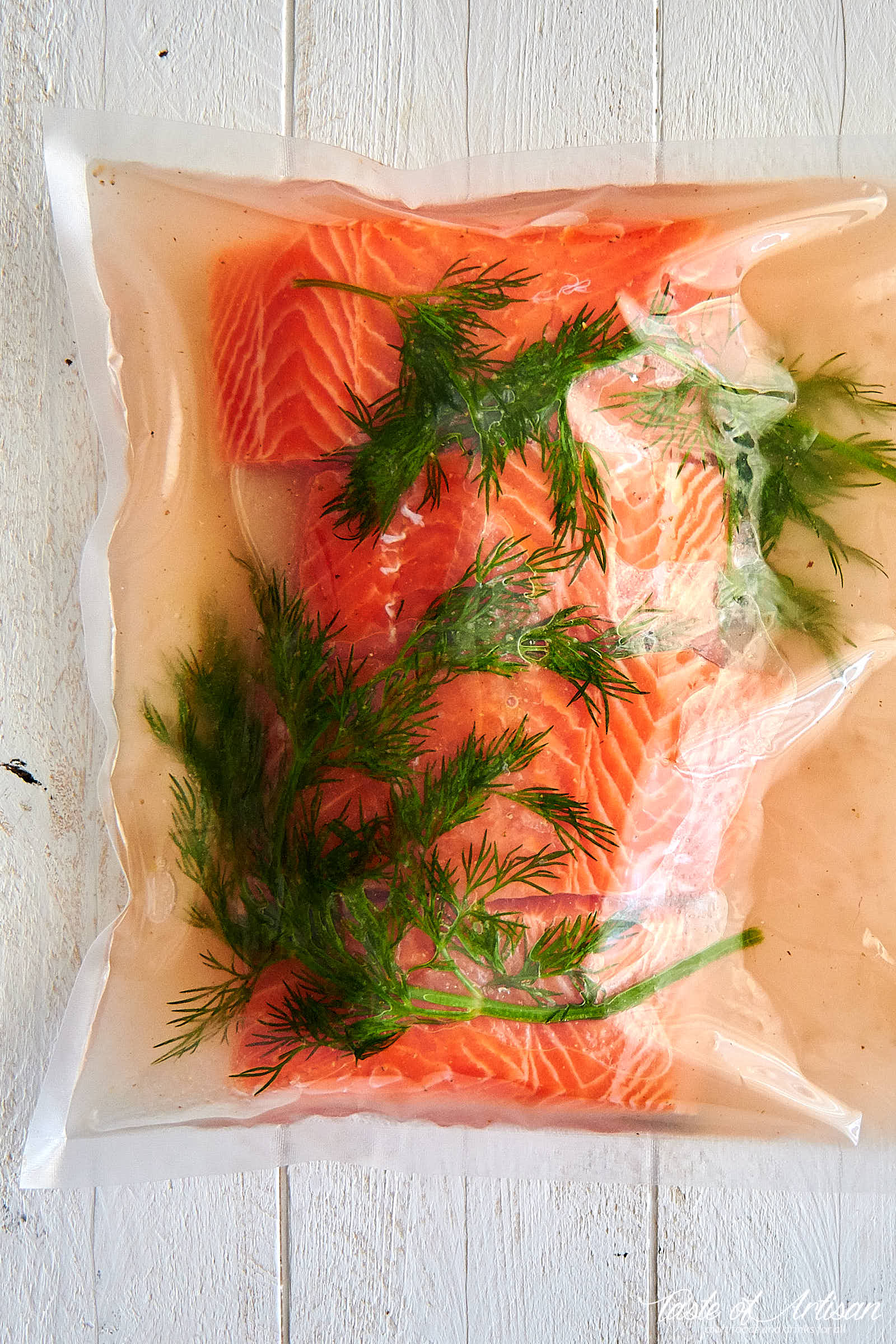
Preparing salmon for sous vide cooking
Once the brining is done, remove salmon fillets from the Ziploc bag, pat dry with a paper towel and place into another (heat resistant) bag. Add a couple of tablespoons of olive oil to prevent the fillets from sticking to each other. Gently remove as much air from the bag as possible and seal. You want to be careful not to squeeze the fillets.
If you have a vacuum sealer, seal the bag with a vacuum sealer on a gentle cycle. Vacuum sealing works the best. If you don't have a vacuum sealer, make sure the bag is big enough so that top end can stay out of the pot and not leak in any water.

Sous vide cooking process for salmon
There are various recommendations on what temperature is best for cooking sous vide salmon. You may find that some vary by 10 degrees or more. In the end, it all depends on personal taste. I tested several temperatures and found that Chef Steps' recommendation of cooking at 122F worked best for me. Others prefer their sous vide salmon a little more well-done and cook at higher temperatures. Just remember, 140F is the absolute maximum temperature you want to go to.

Another thing to keep in mind is the length of the cooking. The good thing about sous vide cooking is that you may cook longer than needed without any ill effect. Some people cook their sous vide salmon for an hour just to be on the safe side and ensure proper cooking. I cook my salmon for 60 minutes regardless of the size and thickness. This takes away any guesswork and makes thing simpler. As a matter of fact, Modernist Cooking Made Easy: Sous Vide: The Authoritative Guide to Low Temperature Precision Cooking recommends cooking salmon at 122F for one hour.
Cooking without an immersion circulator
Let's assume that you want to cook your salmon at 122F. Fill a large pot with hot tap water. In a typical house the hottest water out of the tap is about 123F to 128F. You want to bring the temperature to about 126F. Add cold water to bring the temperature down. Add some boiling hot water to raise the temperature. Have a pot of boiling water ready before the cooking.
The reason why you want to start at 126F is that as soon as you add a couple of cold salmon fillets the temperature will drop to about 122F. The 126F temperature works with a medium (about a 2 gallon) pot. For a larger pot the temperature drop will be smaller. Place the salmon inside the pot and wait for about 2 minutes to let the temperature stabilize. Stir to avoid hot/cold spots. Then check the temperature and adjust as needed. Keep checking the temperature every 7-10 minutes and adjusting as needed. Keep stirring frequently to avoid hot/cold spots.
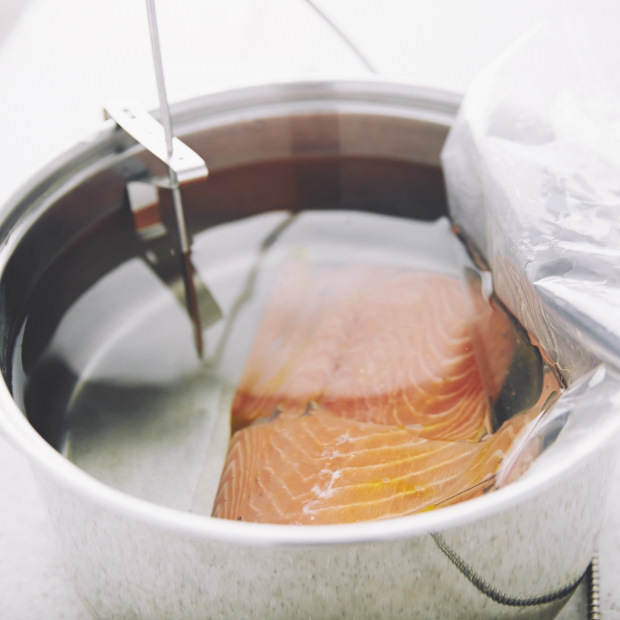
Cooking with an immersion circulator
The preferred method is to use an immersion circulator, like the Anova Sous Vide Immersion Circulator with WiFi that I currently use. This requires an initial investment, which can be significant if you want to invest into a really good model.
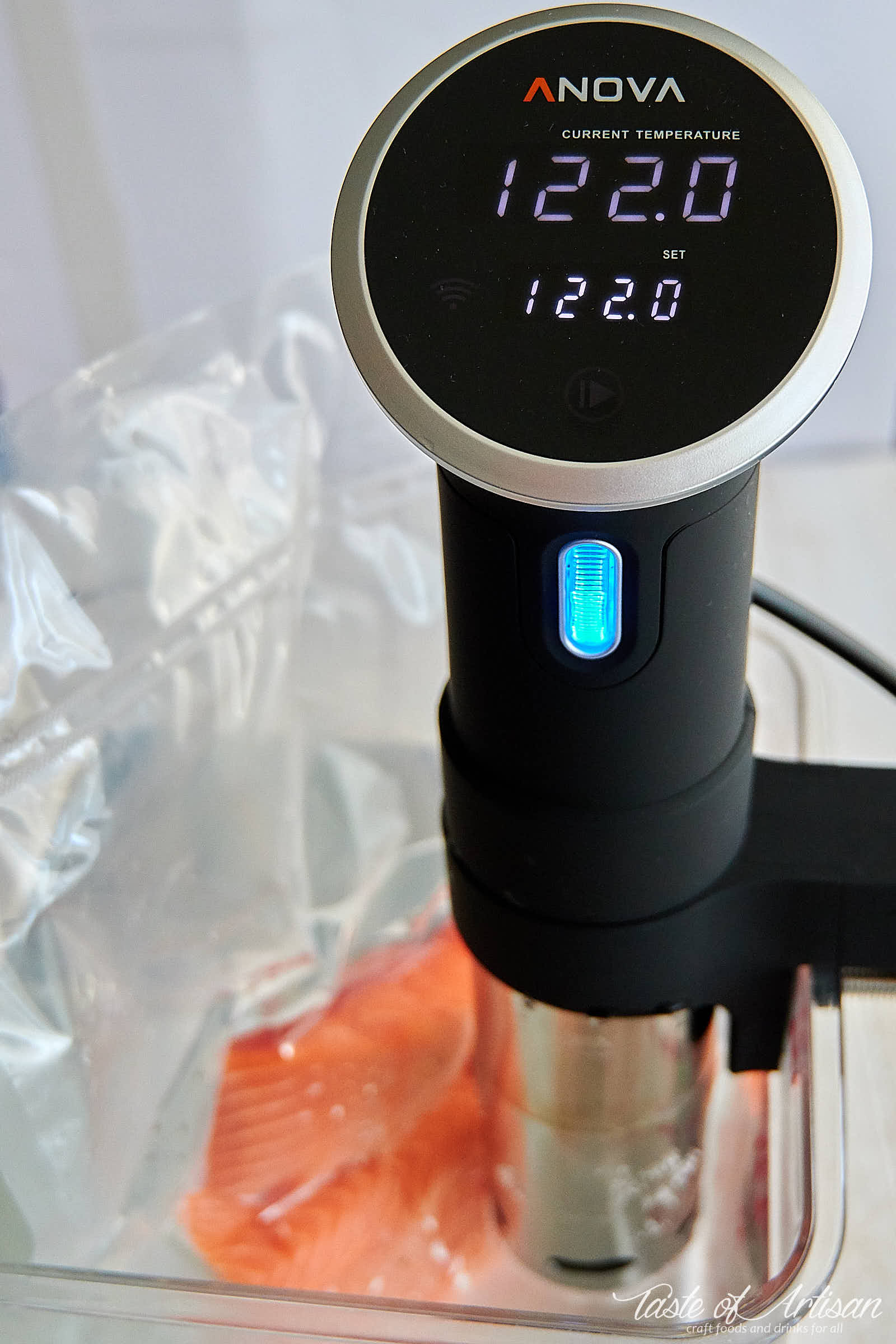
Searing salmon after cooking
You will want to pan sear the salmon fillets after cooking, skin side down. This will add flavor and make the rubbery skin palatable. You don't need to sear the other side. Preheat a skillet with two tablespoons of olive oil. Sear the salmon skin down over high heat for about 45 seconds.
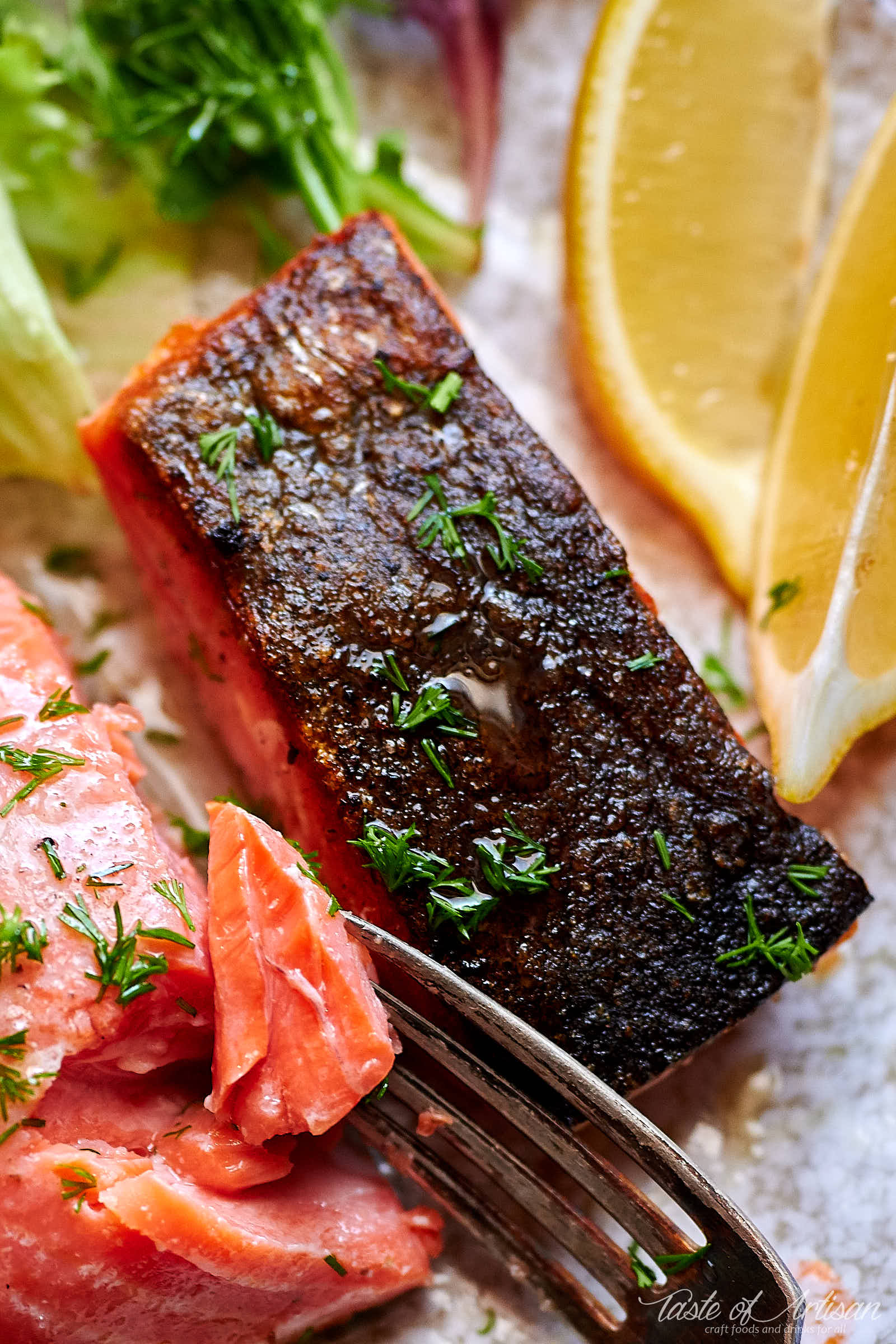
Remove the salmon from the pan and serve your perfectly cooked, moist and flaky sous vide salmon immediately. It will start losing the juices and drying out the longer it sits on the plate.
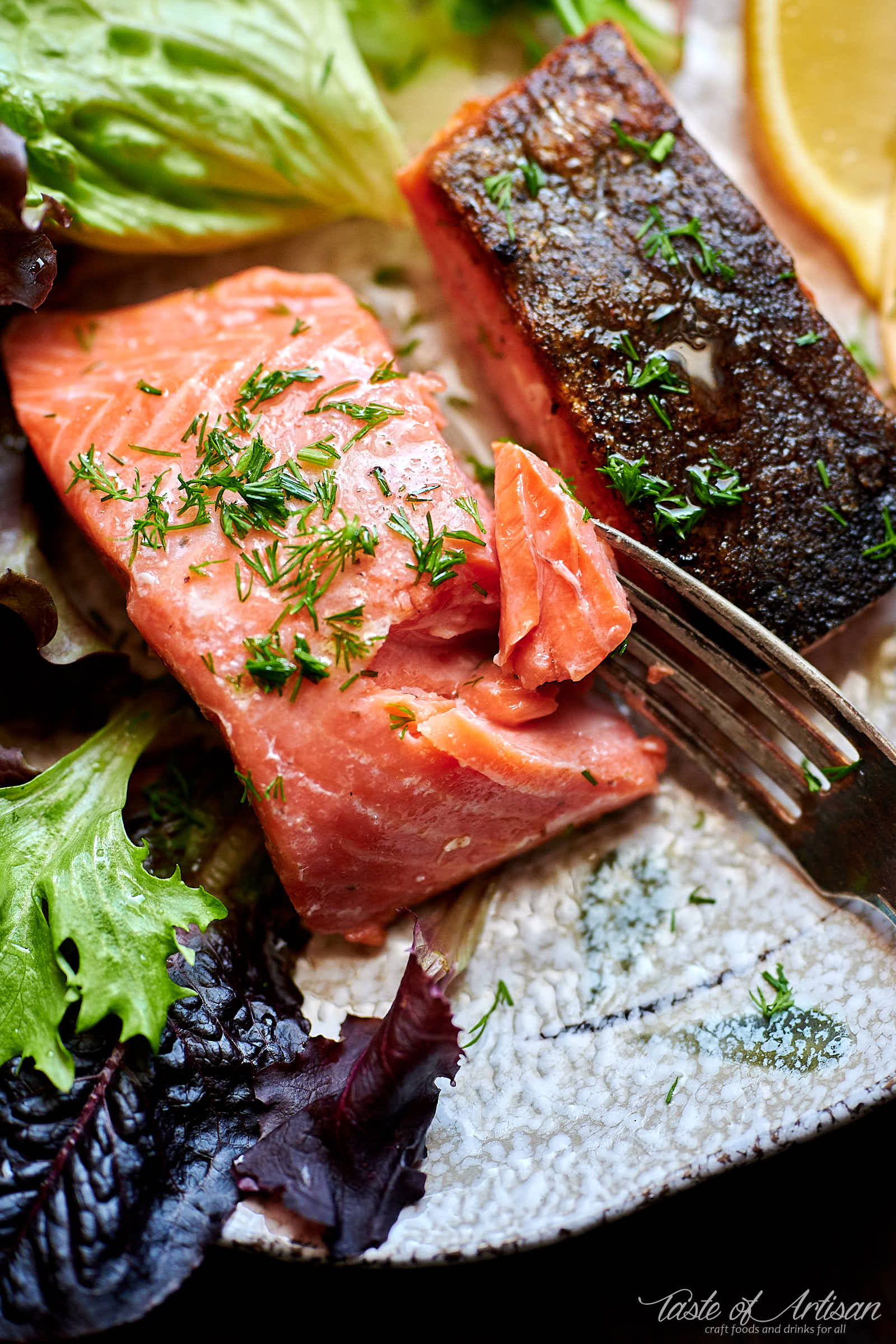
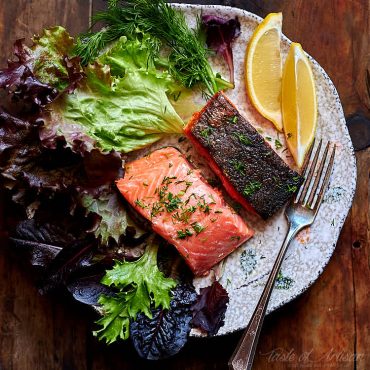
Ingredients
- 1 1/2 lbs salmon fillet (scaled, trimmed, cut into 4 pieces)
- 2 cups ice water
- 4 Tbsp olive oil
- 2 Tbsp kosher salt
- Fresh dill (finely chopped, for garnish)
- Fresh chives (finely chopped, for garnish)
- Lemon (cut in wedges, for garnish)
Instructions
- To prepare the brine, add salt to ice water and stir until the salt is dissolved. Pour the water into a Ziploc bag, add olive oil and stir. You can add herbs and spices to the brine as well to add more flavor. Dill and pepper are commonly added. White pepper may be a better choice as it will be less conspicuous compared to black pepper.
- Add salmon fillets, push out as much air as possible and seal the bag. Refrigerate for about 30 minutes.
- Remove salmon from the Ziploc bag, pat dry with a paper towel and transfer into another bag. Add 1 tablespoon of olive oil to avoid the fillets sticking to each other. Gently remove as much air from the bag as possible and seal. You want to be careful not to squeeze the fish. If you have a vacuum sealer, seal the fish on a gentle cycle to preserve its shape.
- Immerse the sealed bag in preheated water and cook at 122F (or higher depending on the level of doneness you want, see the chart in the notes) for one hour, using a sous vide immersion circulator. If you don't have an immersion circulator, use the method described in the post above.
- Shortly before the cooking is done, preheat a large skillet with 1 tablespoon of olive oil.
- Remove the salmon fillets from the bag and sear skin side down over high heat for 45 seconds. Sprinkle with chopped dill and chives. Serve immediately, with lemon wedges.
Notes

Nutrition
This post was updated on January 22, 2019


Ewoud Vijfwinkel says
just wondering: sous vide food under 52 celsius: isn't that dangerous for micro-organisms? I was always told to al least prepare food above 52/53 celsius
Victor @ Taste of Artisan says
Sous vide cooking is all about cooking at very low temps. The deactivation of harmful bacteria is a function of temperature and time. USDA has a table for various foods that shows how long each needs to be cooked at a certain temp to be safe to eat. For example, chicken needs to reach 163F for a second to be safe to eat. At the same time, cooking chicken to 155F and holding it there for 55 seconds will result in perfectly safe to eat meat.
Sofia says
Awesome recipe. Thanks for sharing.
Roger Tarren says
I love this website. I’ve tried several recipes, all of which produced excellent results. I’m curious as to whether you have tried to cold-smoke salmon on a BGE or if you have any tips for doing so.
Thanks for some terrific advice and how-tos.
Roger
Victor @ Taste of Artisan says
Hi Roger, thank you for the kind words.
About your question, cold-smoking salmon has to be done below 80F. There is absolutely no way that I know of to achieve that on a BGE with good smoke going. I had a hard time achieving and maintaining 140F to smoke kielbasa in my L BGE. What I do is I use my smokehouse with a BGE on the side supplying good quality smoke via a un-insulated flue. This works really well in colder weather.
That said, for cold-smoking, you don't need a smokehouse. I good friend of mine from Dallas who is an avid angler smokes his fish in a large cardboard box. He uses a smoke generator but you can hardly get better smoke than from a properly set up BGE. Thin and blue. Sweet, pleasantly smelling smoke. Get that going then send it to a box or whatever via a 4-6" duct, similar to my setup below.
This will give you pretty good results.
Roger Tarren says
Thanks Victor for your very comprehensive response. I’ve used a Smoke Daddy and an Amazn smoke generator on my Egg with indifferent results. Neither wants to stay lit for the length of time needed to do a good job. Your solution is intriguing and I’ll try this or some version of it next time. Perfect cold smoking weather for the next couple of months.
Thanks again for some great advice. Roger
Victor @ Taste of Artisan says
You are welcome, Roger. Good luck.
Barb says
Tried mine for the first time on the weekend. Did a salmon filet and it was amazing! Cannot wait to try more recipes!
victor says
So happy to hear that!
Stew says
Oh my goodness! The texture of this salmon is so delicate and tender like I've never experienced before. I just got my sous vide setup and will be making more of this type of cooking. Great recipe.
Charles Howlett says
I sous vide this dish, it was very good! I used a lemon infused EVOO, and dill. I need cast iron pan to get the skin nice and crunchy. Served it with roasted vegetables, and jasmine brown rice.
Clement says
Yes! This salmon hit the spot. Really, I did not think if wold be that good but after trying sous vide salmon for the first time I think I prefer it cooked this way by a long shot. Wonderful texture, perfectly cooked.
keerthi says
great recipie got my new sous vide after going through some suggestions... will try this soon.